The Fuzzy Logic Method to Efficiently Optimize Electricity Consumption in Individual Housing
Abstract
:1. Introduction
- A fuzzy logic algorithm to efficiently predict the electricity consumption day-to-day in individual housing. The modeling requires a complete database of real electricity consumption from many instrumented show houses.
- A new home energy management (HEM) algorithm, which implements the fuzzy logic short term load consumption, used both to minimize the cost of electrical energy consumption and to smooth the peak-demand.
2. Methodology
2.1. System Modeling
2.2. Experimental Procedure
2.2.1. Measurement of Electricity Consumption
- Nine power measuring 3-phase terminals.
- One terminal with four 24 V dc input digital channels.
2.2.2. Electricity Consumption Monitoring in Reference Houses
- N: Number of samples.
- : Real power demand for time t (W).
- : Flexible power demand for time t (W).
- : Cost of electricity (Euros).
- N: Number of sampling.
- : Real power demand for time t (W).
- : Duration between two samples (s).
- : Cost of the electricity at time t (Euros/kWh).
2.3. Load Curve Modeling
2.3.1. Methodology
- Cycle and time-limited operation.
- Continuous cycle operation (type ON/OFF).
- No cycle (Computer, TV etc.).
2.3.2. Example of Modeling for a Fridge
2.3.3. Example of Modeling for a Washing Machine
2.3.4. The Importance of Sampling
3. Short Term Prediction of Load Consumption
3.1. Foreword
3.2. Main Inputs to Build the Prediction Model
3.2.1. Input 1: Time
3.2.2. Input 2: Day
3.2.3. Input 3: Past Electricity Consumption
3.2.4. Inputs 4 and 5: Past Temperatures
3.2.5. Input 6: Predicted Temperature
3.3. The Fuzzy Logic as a Versatile Method Used to Predict Electricity Consumption
- The fuzzification used to convert the digital inputs into fuzzy inputs.
- The fuzzy rules necessary to stem from a learning phase to get a better understanding of the users’ habits.
- The fuzzy inference which uses the table of rules to find the electricity consumption.
- The defuzzification used to convert the fuzzy values into digital values.
- Input 2 (day): two intervals (trapezoidal membership functions).
- Input 3 (past electricity consumption): 299 intervals (triangular membership functions).
- Input 4 and 5 (past temperatures): eight intervals (trapezoidal membership functions).
- Input 6 (predicted temperature): eight intervals (trapezoidal membership functions).
- : Prediction error for time t.
- : Real power demand for time t.
- : Predicted power demand for time t.
- N: Number of samples.
- If ( is “LM”) and (DAY is “WEEK”) and (TIME is “H10”), then (Load is “LOW140”).
- If ( is “MHNM”) and (DAY is “WEEKEND”) and (TIME is “H10”), then (Load is “HIGH52”).
3.4. Relevance of the Fuzzy Logic Approach : Example of Results
4. Energy Management: Examples of Results and Discussion
4.1. New HEM Algorithm Proposal
- : Cost of the electricity consumption (Euros).
- : Cost of the electricity at time named t (Euros).
- . : Number of samples.
- : Efficiency of the storage system.
- . : Duration between 2 points (s).
- The discomfort (Dis) from 0 (0%) to 0.5 (100%).
- The use of the storage system (Su) from 0 (0%) to 0.5 (100%).
- The savings (Cs) from 0 (0%) to 1 (100%).
4.2. Examples of Simulation Results
4.2.1. Smart Control of the Loads
- 288 kWh/year for a dishwasher.
- 192 kWh/year for a tumble dryer.
- 173 kWh/year for a washing machine (A+++-type).
4.2.2. Use of the Storage System in an Efficient Way
4.3. Discussion
5. Conclusions and Prospects
- The STLF algorithm based on the fuzzy logic method gave sufficient results. Many simulation results highlighted the importance of the database of real measurements to warrant an accurate prediction.
- Both simulation and experimental results highlighted the difficulty to predict STLF when a dwelling is not equipped with an electric heating.
- The electricity management system proposed in this manuscript was intended to smooth the peak demand. This can be mainly achieved using a smart control of the storage system. In particular, the HEMS allows any user to manage his energy consumption, and “reshape” the load profile. A compromise was finally highlighted between electricity waste and the reduction of the peak demand.
- The HEMS proposed in this article emphasized its strong flexibility in not disturbing the users’ comfort by scheduling home appliances.
Acknowledgments
Author Contributions
Conflicts of Interest
Abbreviation
| ANN | Artificial Neural Networks |
| AP | Appliance |
| ARIMA | Auto Regressive Integrated Moving Average |
| AWNN | Advanced Wavelet Neural Network |
| FLR | Flexibility Load Range |
| HEMS | Home Energy Management System |
| LTLF | Long Term Load Forecasting |
| MTLF | Medium Term Load Forecasting |
| RMSE | Root Mean Square Error |
| STLF | Short Term Load Forecasting |
References
- U.S. Energy Information Administration. International Energy Outlook 2017; U.S. Energy Information Administration: Washington, DC, USA, 2017.
- Dynamic Pricing in Electricity Supply—A Eurelectric Position Paper. Available online: http://www.eurelectric.org/media/309103/dynamic_pricing_in_electricity_supply-2017-2520-0003-01-e.pdf (accessed on 11 February 2017).
- Mahmood, D.; Javaid, N.; Alrajeh, N.; Khan, Z.A.; Qasim, U.; Ahmed, I.; Ilahi, M. Realistic Scheduling Mechanism for Smart Homes. Energies 2016, 9, 202. [Google Scholar] [CrossRef]
- International Organization for Standardization. ISO 50001—Energy Management Systems—Requirements with Guidance for Use; International Organization for Standardization: Geneva, Switzerland, 2011. [Google Scholar]
- Laskurain, I.; Heras-Saizarbitoria, I.; Casadesús, M. Fostering renewable energy sources by standards for environmental and energy management. Renew. Sustain. Energy Rev. 2015, 50, 1148–1156. [Google Scholar] [CrossRef]
- Zobel, T.; Malmgren, C. Evaluating the Management System Approach for Industrial Energy Efficiency Improvements. Energies 2016, 9, 774. [Google Scholar] [CrossRef]
- Pau, G.; Collotta, M.; Ruano, A.; Qin, J. Smart Home Energy Management. Energies 2017, 10, 382. [Google Scholar] [CrossRef]
- Bae, H.; Yoon, J.; Lee, Y.; Lee, J.; Kim, T.; Yu, J.; Cho, S. User-friendly demand side management for smart grid networks. In Proceedings of the 2014 International Conference on Information Networking (ICOIN2014), Phuket, Thailand, 10–12 February 2014; pp. 481–485. [Google Scholar]
- Mohsenian-Rad, A.-H.; Wong, V.W.S.; Jatskevich, J.; Schober, R.; Leon-Garcia, A. Autonomous Demand-Side Management Based on Game-Theoretic Energy Consumption Scheduling for the Future Smart Grid. IEEE Trans. Smart Grid 2010, 1, 320–331. [Google Scholar] [CrossRef]
- Rodrigues, E.M.G.; Godina, R.; Shafie-khah, M.; Catalão, J.P.S. Experimental Results on a Wireless Wattmeter Device for the Integration in Home Energy Management Systems. Energies 2017, 10, 398. [Google Scholar] [CrossRef]
- Ryu, S.; Noh, J.; Kim, H. Deep Neural Network Based Demand Side Short Term Load Forecasting. Energies 2017, 10, 3. [Google Scholar] [CrossRef]
- Buitrago, J.; Asfour, S. Short-Term Forecasting of Electric Loads Using Nonlinear Autoregressive Artificial Neural Networks with Exogenous Vector Inputs. Energies 2017, 10, 40. [Google Scholar] [CrossRef]
- Hernández-Hernández, C.; Rodríguez, F.; da Costa Mendes, P.R.; Normey-Rico, J.E.; Guzmán, J.L. The Comparison Study of Short-Term Prediction Methods to Enhance the Model Predictive Controller Applied to Microgrid Energy Management. Energies 2017, 10, 884. [Google Scholar] [CrossRef]
- Zheng, H.; Yuan, J.; Chen, L. Short-Term Load Forecasting Using EMD-LSTM Neural Networks with a Xgboost Algorithm for Feature Importance Evaluation. Energies 2017, 10, 1168. [Google Scholar] [CrossRef]
- Palensky, P.; Dietrich, D. Demand Side Management: Demand Response, Intelligent Energy Systems, and Smart Loads. IEEE Trans. Ind. Inform. 2011, 7, 381–388. [Google Scholar] [CrossRef]
- Setlhaolo, D.; Xia, X. Optimal scheduling of household appliances with a battery storage system and coordination. Energy Build. 2015, 94, 61–70. [Google Scholar] [CrossRef]
- Esther, B.P.; Kumar, K.S. A survey on residential Demand Side Management architecture, approaches, optimization models and methods. Renew. Sustain. Energy Rev. 2016, 59, 342–351. [Google Scholar] [CrossRef]
- Rasheed, M.; Javaid, N.; Awais, M.; Khan, Z.; Qasim, U.; Alrajeh, N.; Iqbal, Z.; Javaid, Q. Real Time Information Based Energy Management Using Customer Preferences and Dynamic Pricing in Smart Homes. Energies 2016, 9, 542. [Google Scholar] [CrossRef]
- Dolara, A.; Grimaccia, F.; Magistrati, G.; Marchegiani, G. Optimization Models for Islanded Micro-Grids: A Comparative Analysis between Linear Programming and Mixed Integer Programming. Energies 2017, 10, 241. [Google Scholar] [CrossRef]
- Ahmad, A.; Khan, A.; Javaid, N.; Hussain, H.M.; Abdul, W.; Almogren, A.; Alamri, A.; Azim Niaz, I. An Optimized Home Energy Management System with Integrated Renewable Energy and Storage Resources. Energies 2017, 10, 549. [Google Scholar] [CrossRef]
- Ghiassi, M.; Zimbra, D.K.; Saidane, H. Medium term system load forecasting with a dynamic artificial neural network model. Electr. Power Syst. Res. 2006, 76, 302–316. [Google Scholar] [CrossRef]
- Ali, D.; Yohanna, M.; Puwu, M.I.; Garkida, B.M. Long-term load forecast modelling using a fuzzy logic approach. Pac. Sci. Rev. A Nat. Sci. Eng. 2016, 18, 123–127. [Google Scholar] [CrossRef]
- Sadaei, H.J.; Guimarães, F.G.; da Silva, C.J.; Hisyam Lee, M.; Eslami, T. Short-term load forecasting method based on fuzzy time series, seasonality and long memory process. Int. J. Approx. Reason. 2017, 83, 196–217. [Google Scholar] [CrossRef]
- Byeon, G.; Yoon, T.; Oh, S.; Jang, G. Energy Management Strategy of the DC Distribution System in Buildings Using the EV Service Model. IEEE Trans. Power Electron. 2013, 28, 1544–1554. [Google Scholar] [CrossRef]
- Rana, M.; Koprinska, I. Forecasting electricity load with advanced wavelet neural networks. Neurocomputing 2016, 182, 118–132. [Google Scholar] [CrossRef]
- Barak, S.; Sadegh, S.S. Forecasting energy consumption using ensemble ARIMA–ANFIS hybrid algorithm. Int. J. Electr. Power Energy Syst. 2016, 82, 92–104. [Google Scholar] [CrossRef]
- Liao, G.-C.; Tsao, T.-P. Application of fuzzy neural networks and artificial intelligence for load forecasting. Electr. Power Syst. Res. 2004, 70, 237–244. [Google Scholar] [CrossRef]
- Clements, A.E.; Hurn, A.S.; Li, Z. Forecasting day-ahead electricity load using a multiple equation time series approach. Eur. J. Oper. Res. 2016, 251, 522–530. [Google Scholar] [CrossRef]
- Jovanović, R.Ž.; Sretenović, A.A.; Živković, B.D. Ensemble of various neural networks for prediction of heating energy consumption. Energy Build. 2015, 94, 189–199. [Google Scholar] [CrossRef]
- Kavaklioglu, K.; Ceylan, H.; Ozturk, H.K.; Canyurt, O.E. Modeling and prediction of Turkey’s electricity consumption using Artificial Neural Networks. Energy Convers. Manag. 2009, 50, 2719–2727. [Google Scholar] [CrossRef]
- Yuce, B.; Mourshed, M.; Rezgui, Y. A Smart Forecasting Approach to District Energy Management. Energies 2017, 10, 1073. [Google Scholar]
- Pappas, S.S.; Ekonomou, L.; Karamousantas, D.C.; Chatzarakis, G.E.; Katsikas, S.K.; Liatsis, P. Electricity demand loads modeling using AutoRegressive Moving Average (ARMA) models. Energy 2008, 33, 1353–1360. [Google Scholar] [CrossRef]
- Azadeh, A.; Saberi, M.; Seraj, O. An integrated fuzzy regression algorithm for energy consumption estimation with non-stationary data: A case study of Iran. Energy 2010, 35, 2351–2366. [Google Scholar] [CrossRef]
- Chaturvedi, D.K.; Sinha, A.P.; Malik, O.P. Short term load forecast using fuzzy logic and wavelet transform integrated generalized neural network. Int. J. Electr. Power Energy Syst. 2015, 67, 230–237. [Google Scholar] [CrossRef]
- Mamlook, R.; Badran, O.; Abdulhadi, E. A fuzzy inference model for short-term load forecasting. Energy Policy 2009, 37, 1239–1248. [Google Scholar] [CrossRef]
- Castro Torrini, F.; Castro Souza, R.; Cyrino Oliveira, F.L.; Moreira Passanha, J.F. Long term electricity consumption forecast in Brazil: A fuzzy logic approach. Socioecon. Plann. Sci. 2016, 54, 18–27. [Google Scholar] [CrossRef]
- Berlad, A.L.; Salzano, F.J.; Batey, J. On enthalpy management in small buildings. Energy 1976, 1, 429–443. [Google Scholar] [CrossRef]
- Lobaccaro, G.; Carlucci, S.; Löfström, E. A Review of Systems and Technologies for Smart Homes and Smart Grids. Energies 2016, 9, 348. [Google Scholar] [CrossRef]
- Strbac, G. Demand side management: Benefits and challenges. Energy Policy 2008, 36, 4419–4426. [Google Scholar] [CrossRef]
- Setlhaolo, D.; Xia, X. Combined residential demand side management strategies with coordination and economic analysis. Int. J. Electr. Power Energy Syst. 2016, 79, 150–160. [Google Scholar] [CrossRef]
- How Much Energy Do My Household Appliances Use?—Energuide. Available online: https://www.energuide.be/en/questions-answers/how-much-energy-do-my-household-appliances-use/71/ (accessed on 11 August 2017).
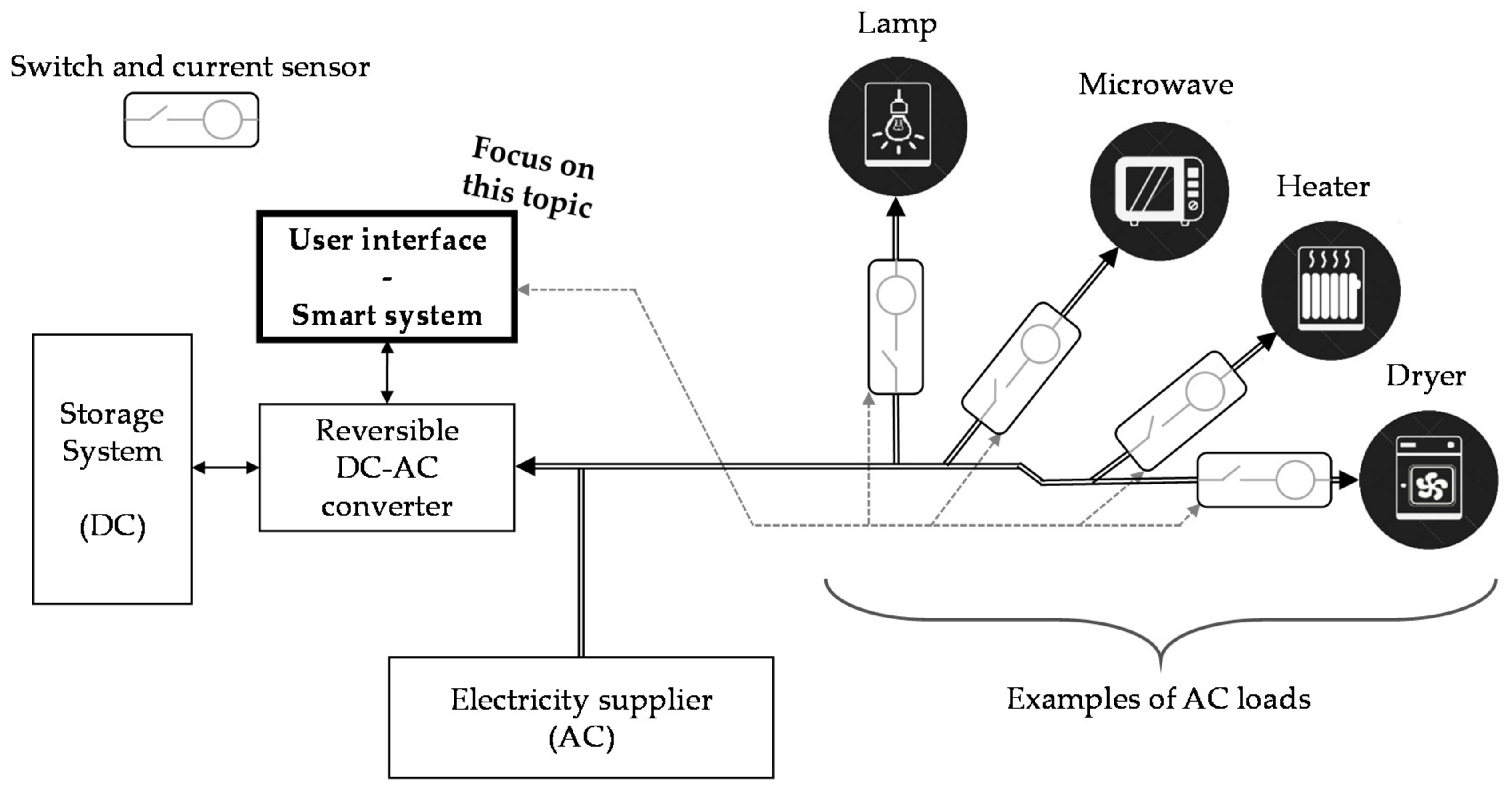

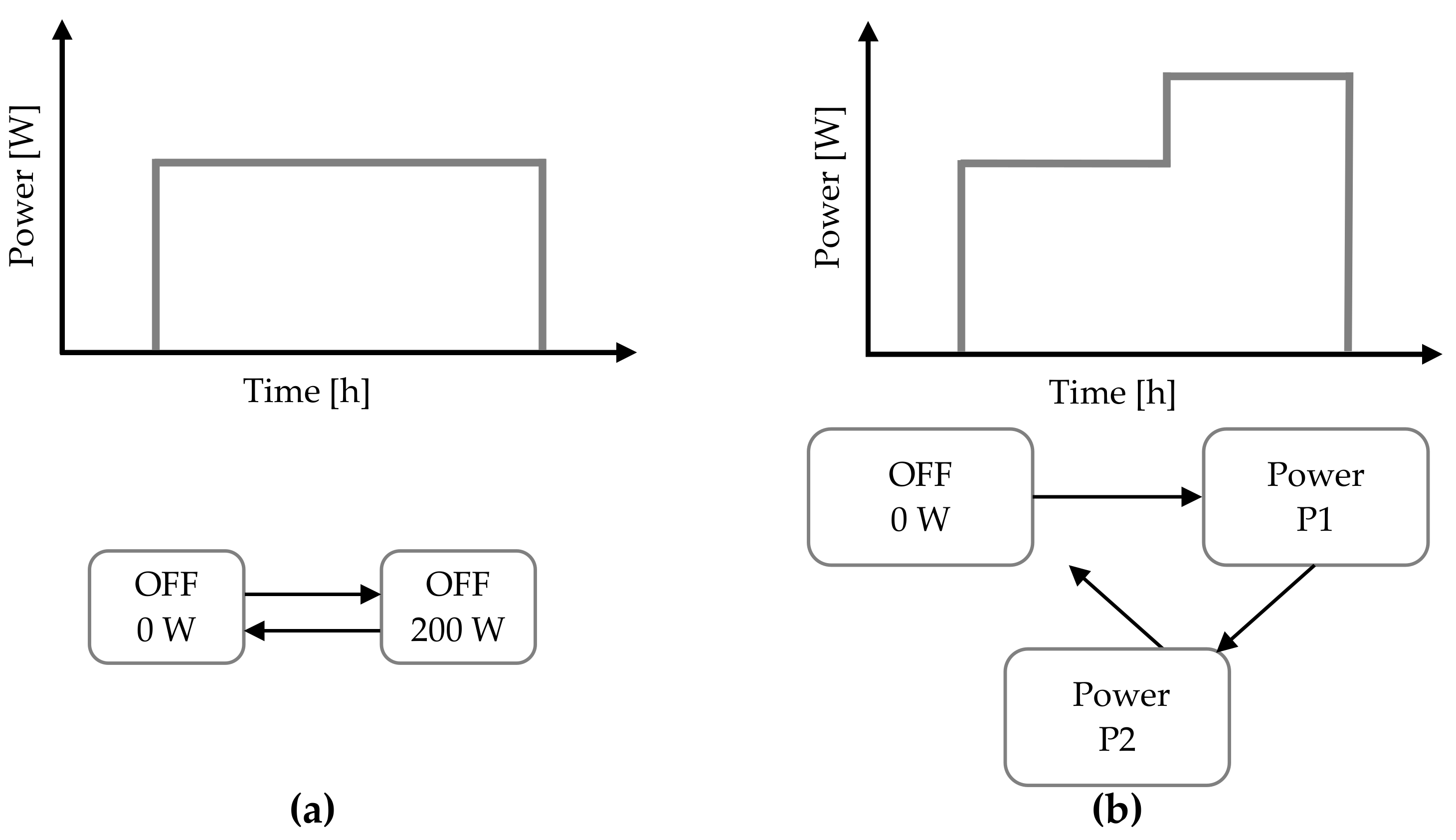

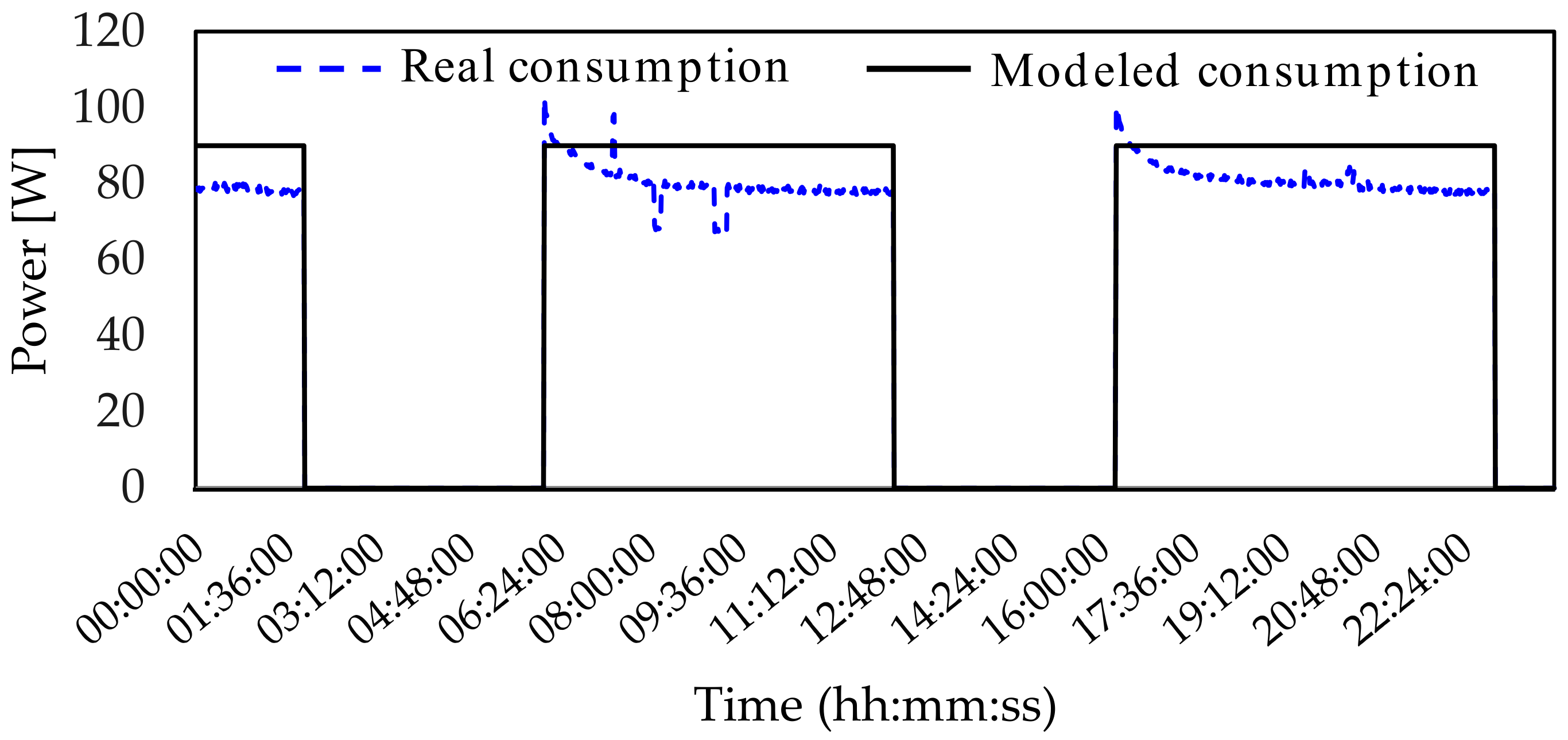
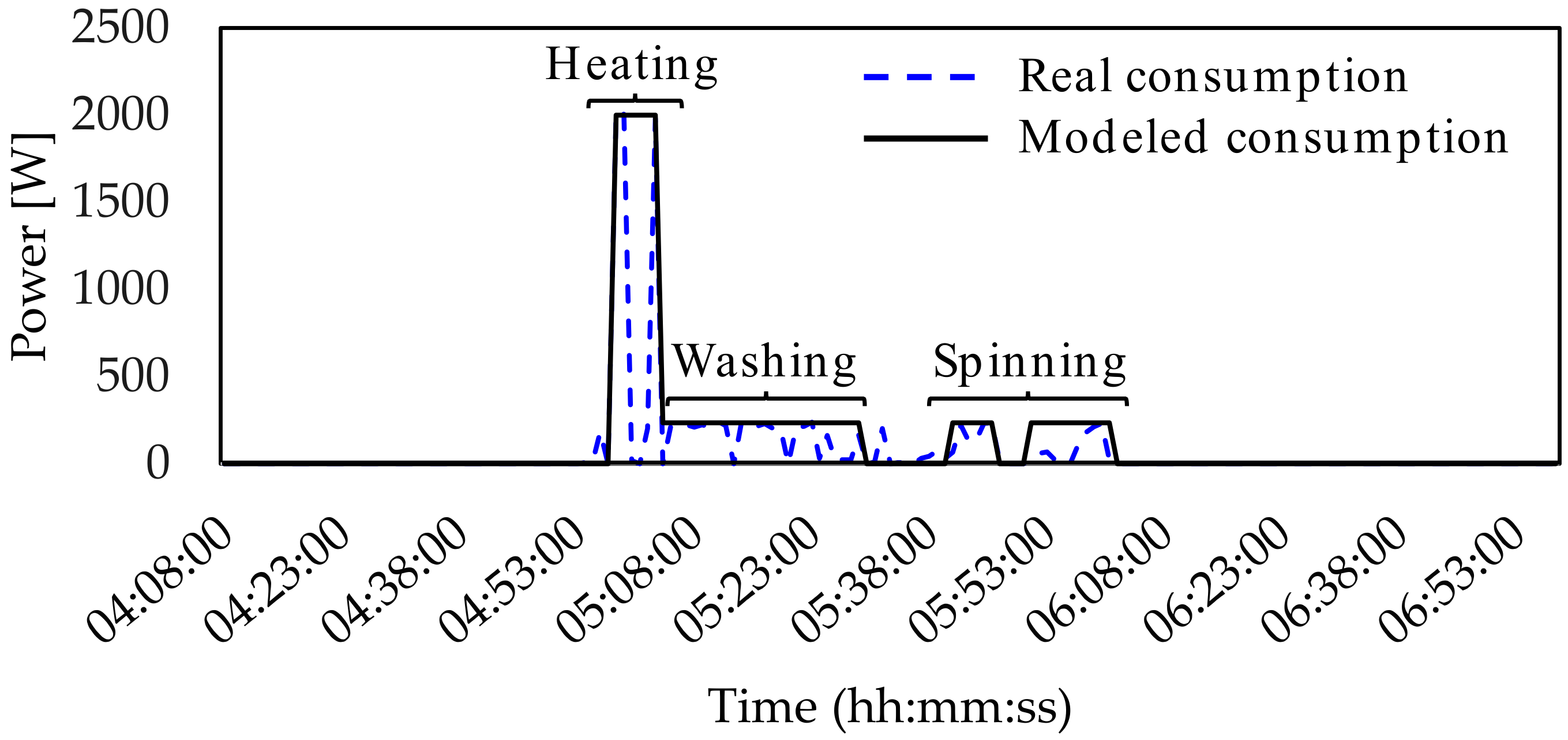

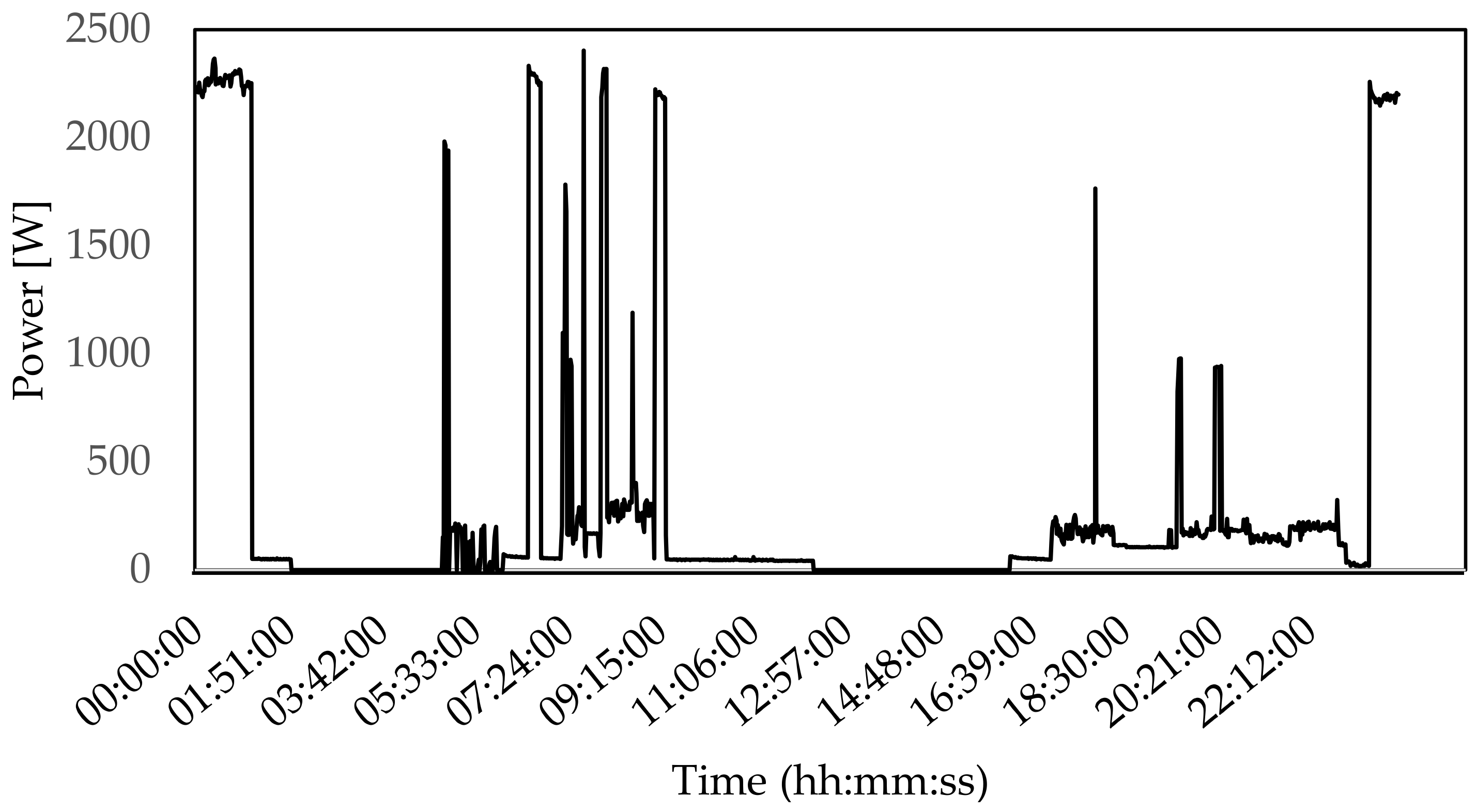
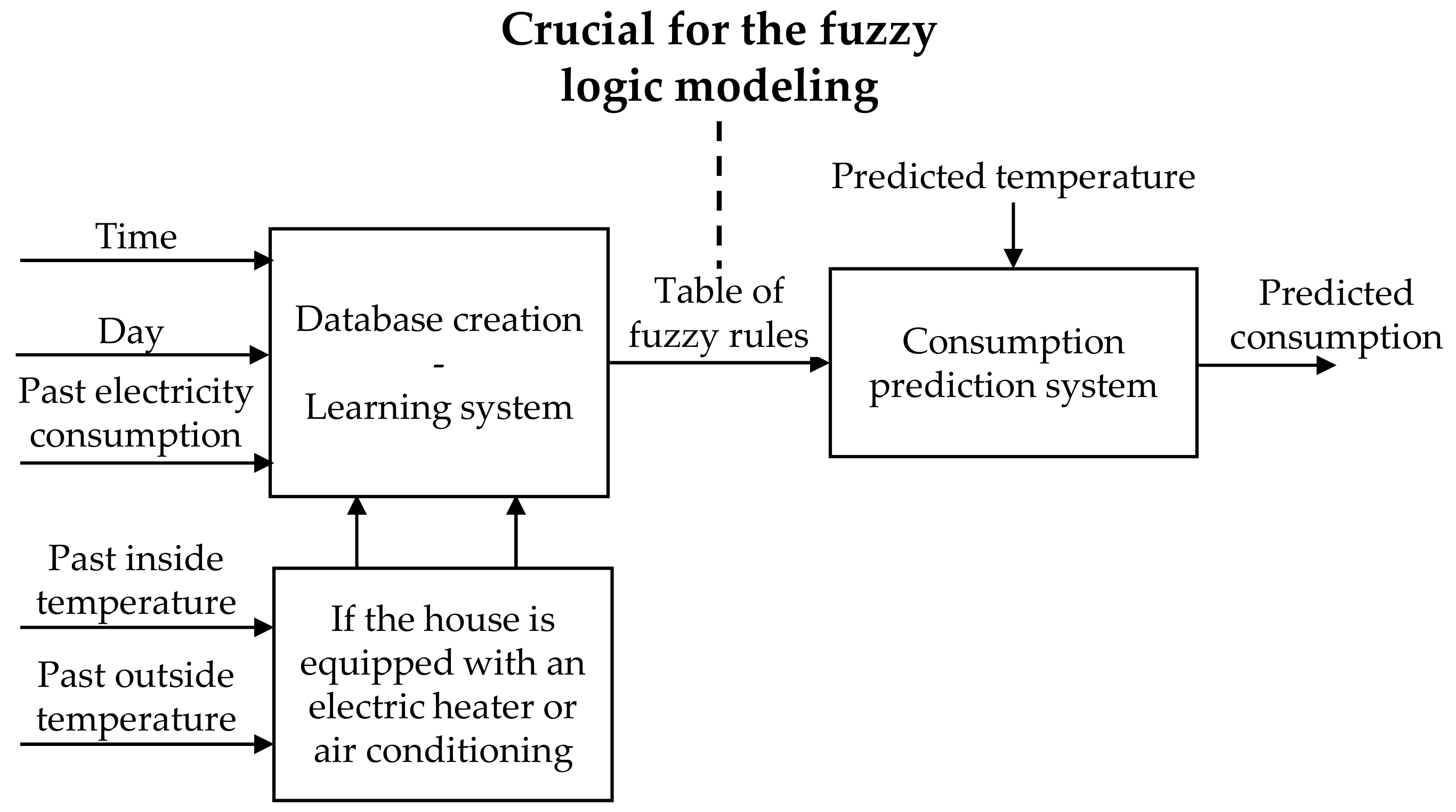
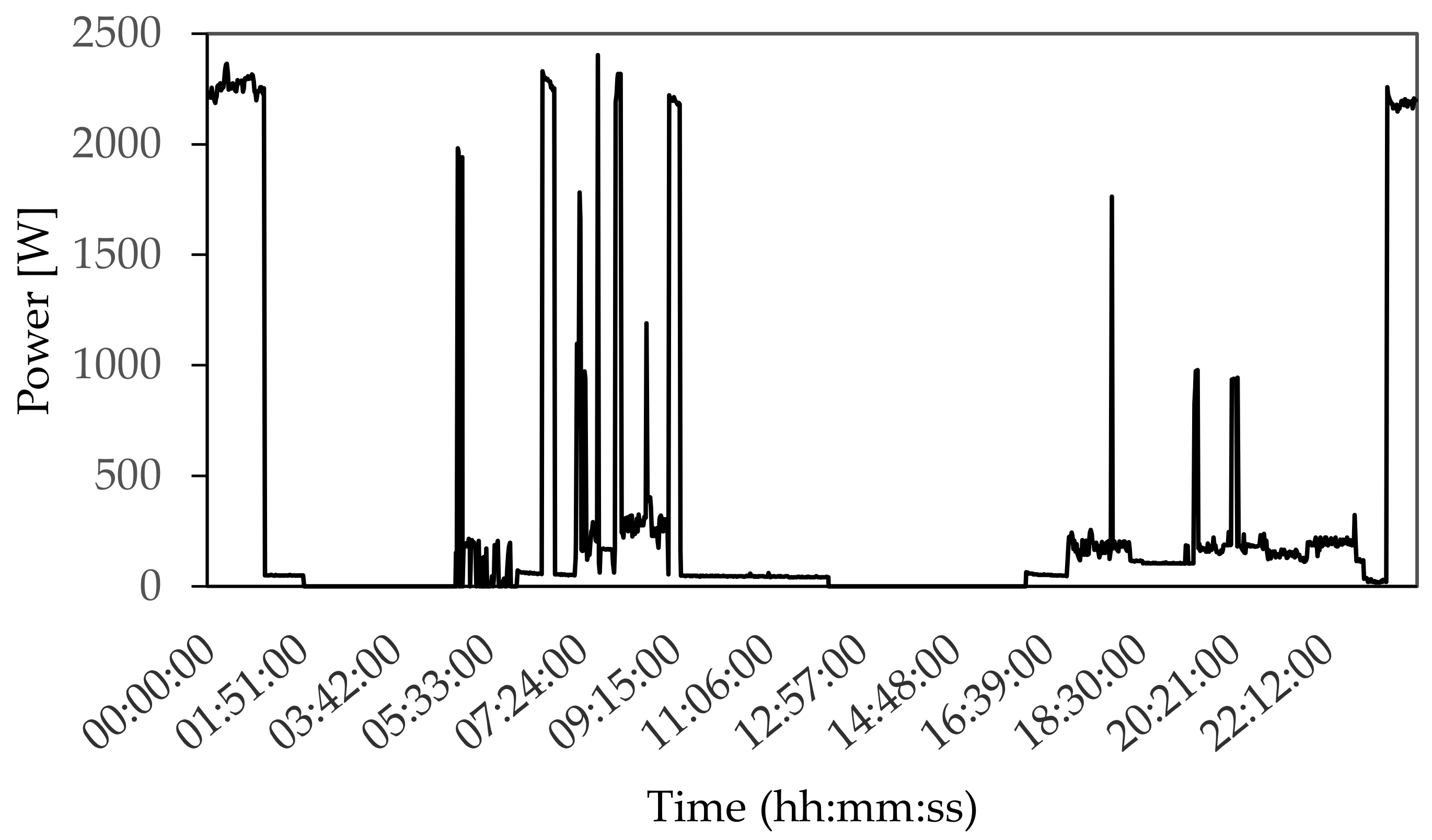
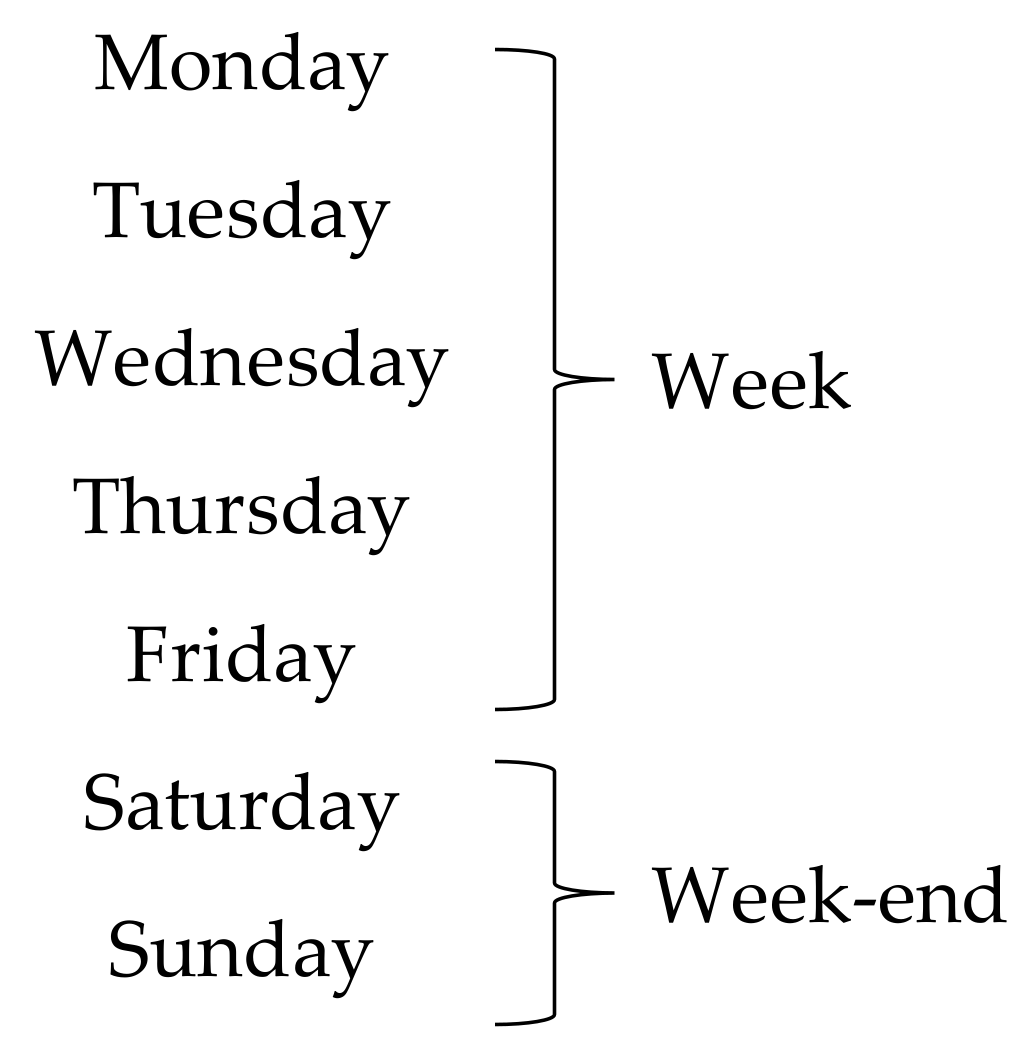

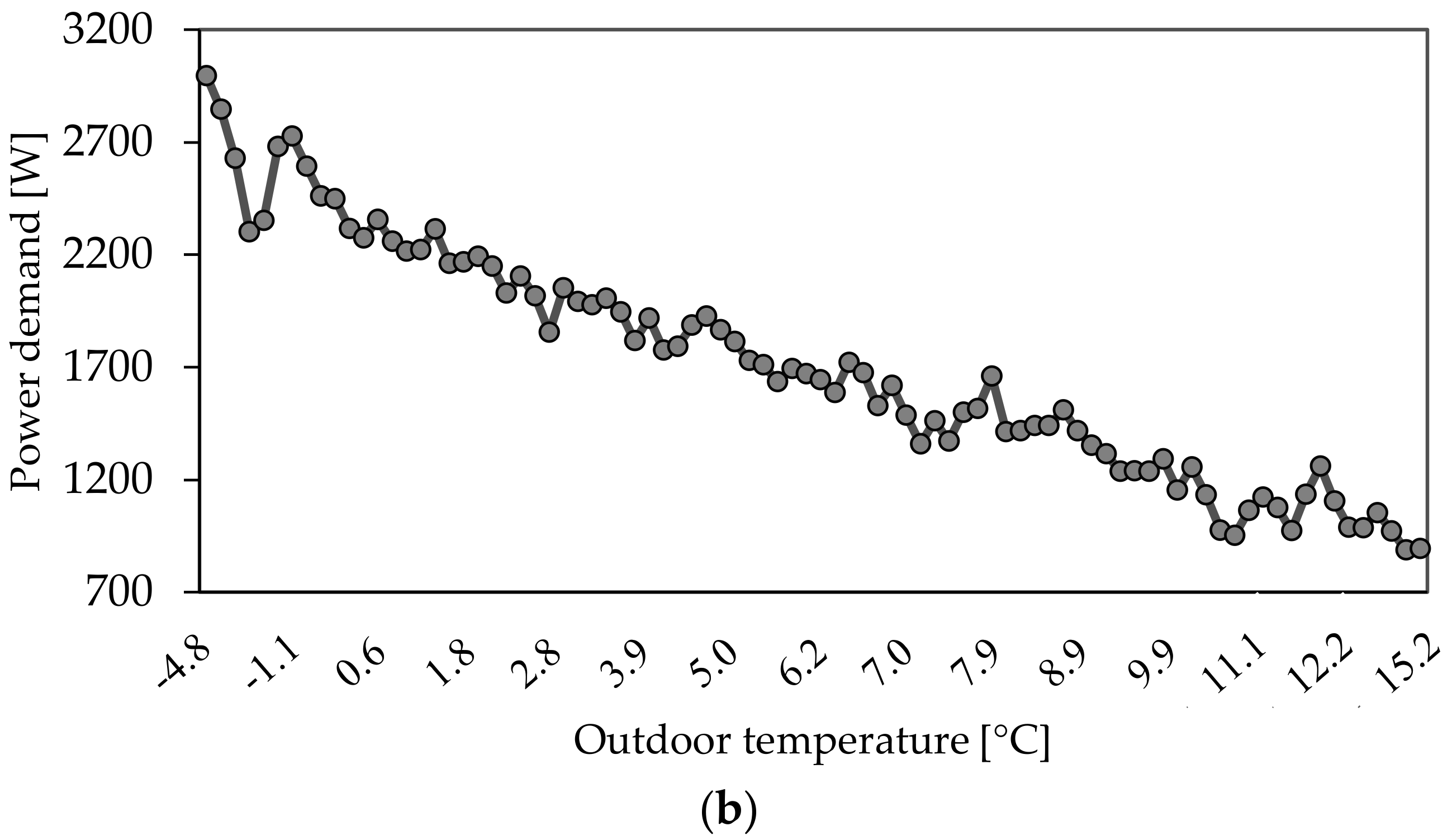
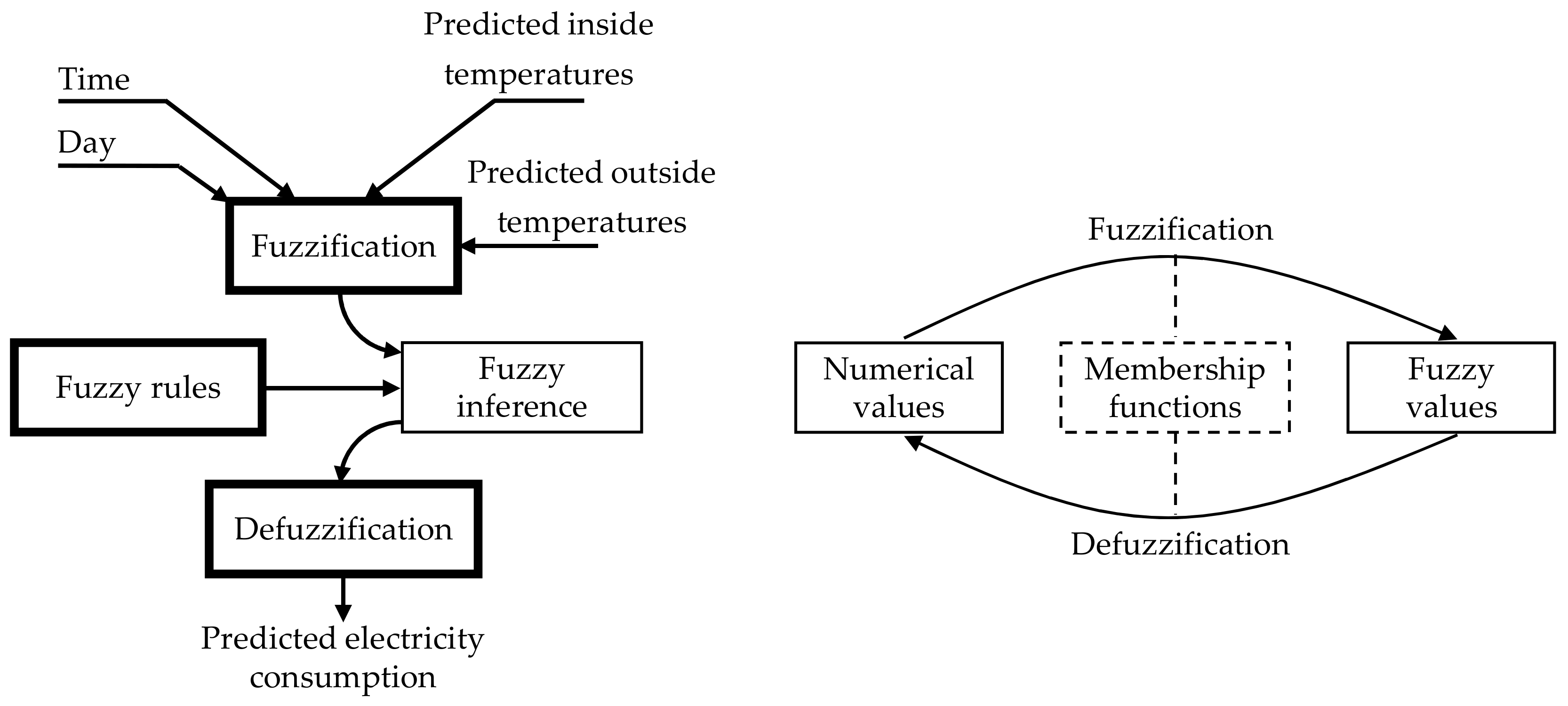

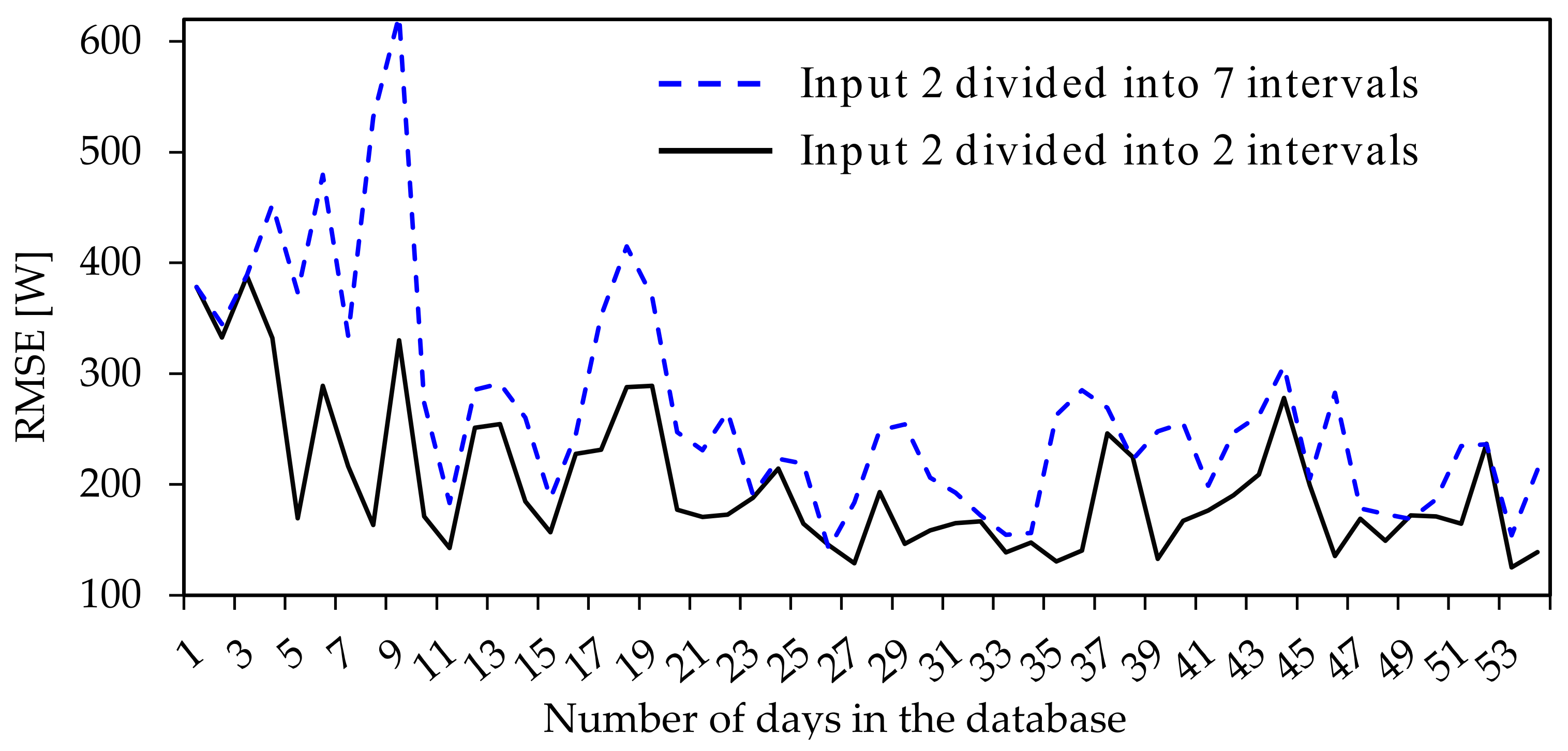
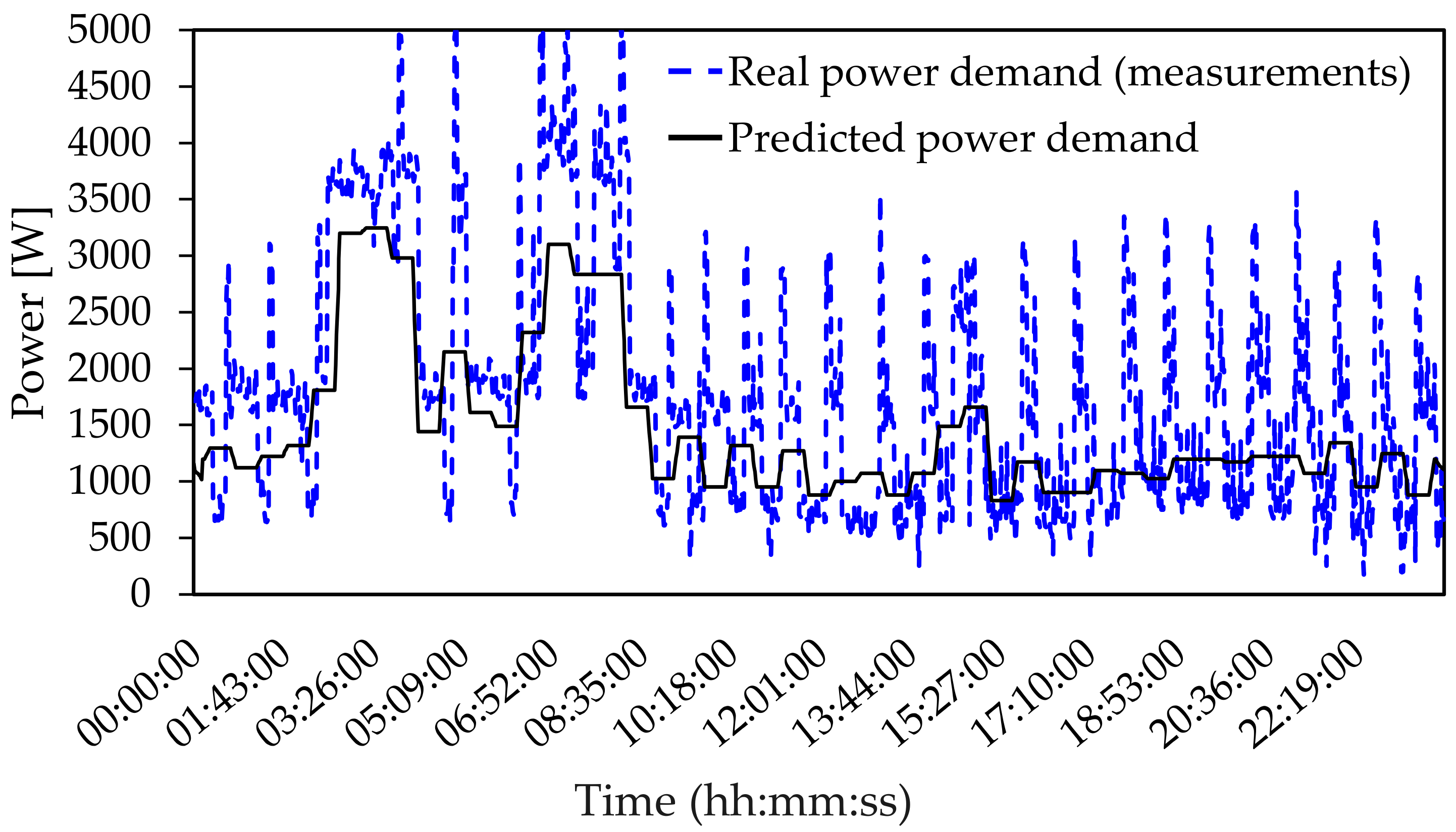
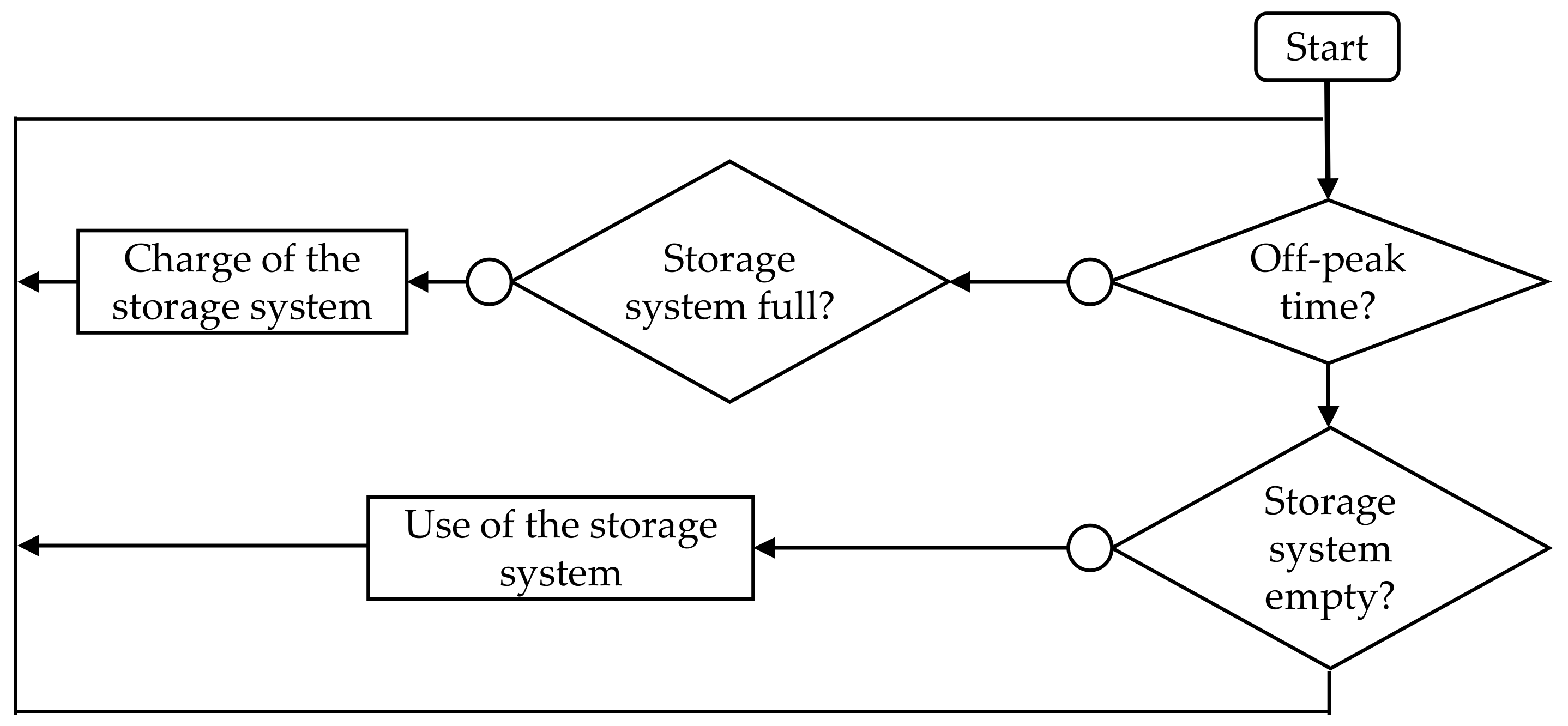
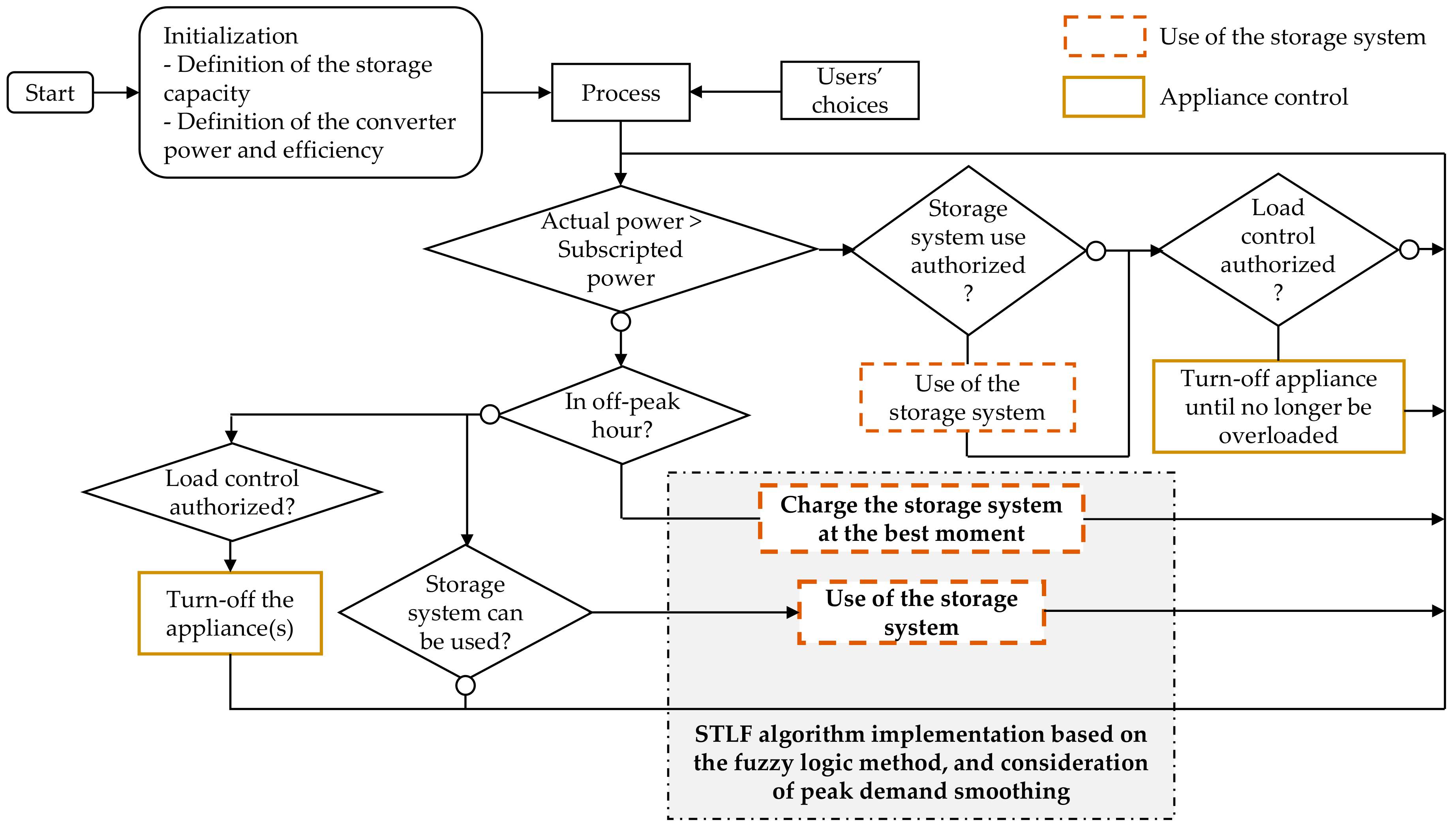

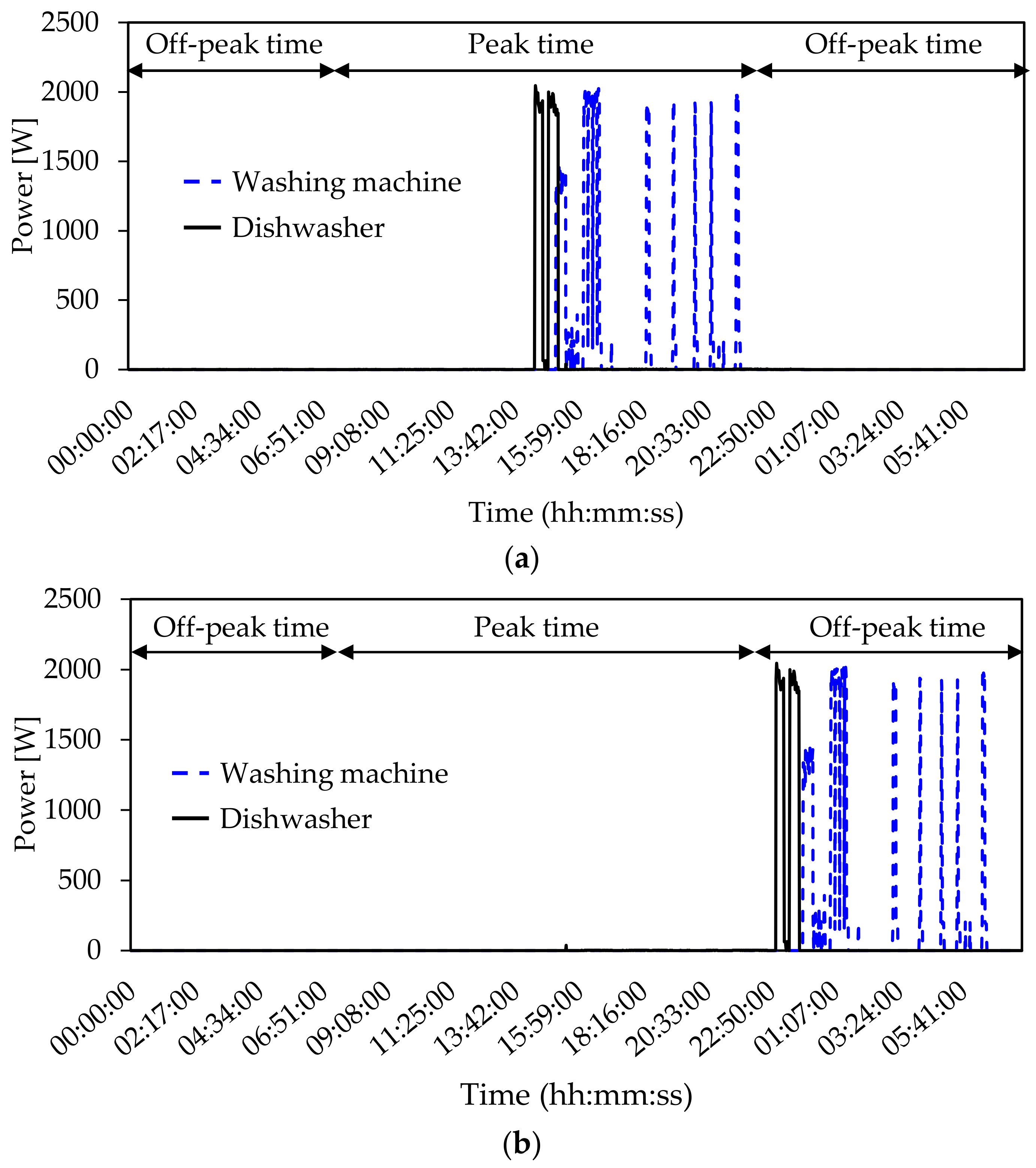

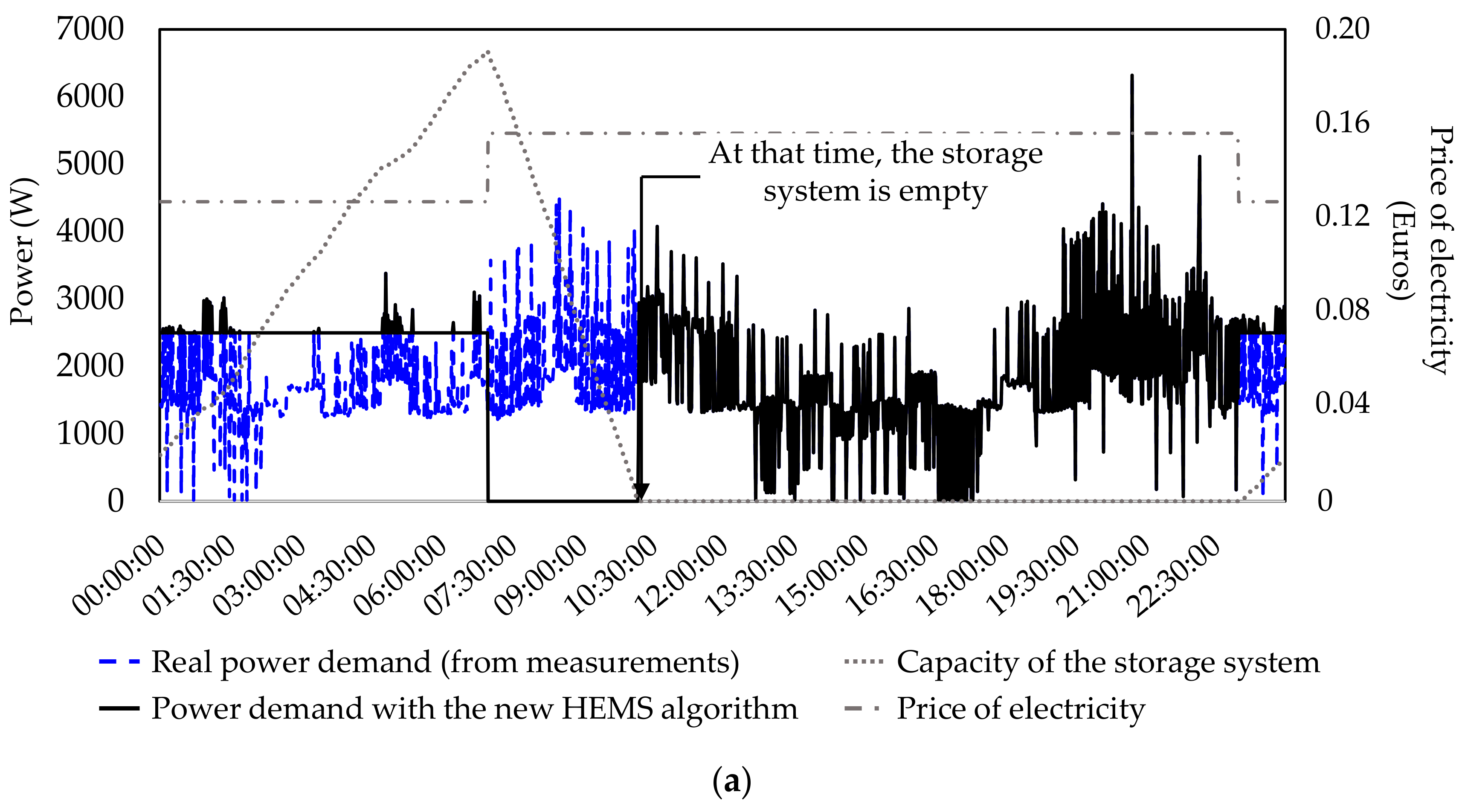
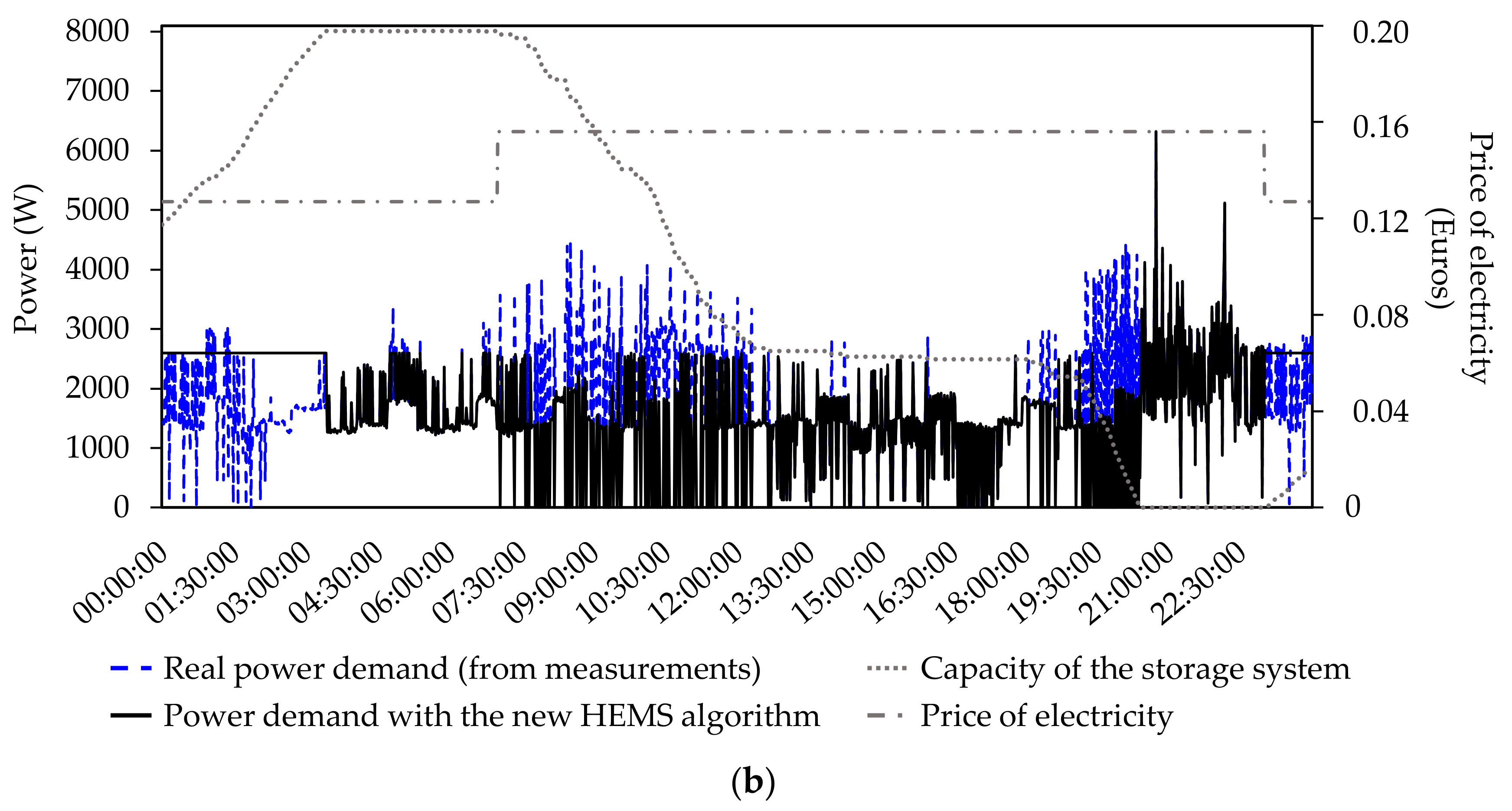
| House Type No. | House Type | Surface Area (m2) | Small Appliances Consumption (Wh/Day) | Consumption of Energy-Inefficient Appliances (Wh/Day) | Monthly Invoice * (Euros) | Season of the Experimentation |
|---|---|---|---|---|---|---|
| 1 | House | 130 | 2773 | 38,190 | 170 | Winter |
| 2 | Apartment | 50 | 1701 | 2708 | 15.6 | Autumn |
| 3 | Apartment | 35 | 2566 | 6084 | 26.8 | Autumn |
| 4 | House | 100 | 3783 | 5483 | 39 | Summer |
| 5 | House | 150 | 11,942 | 45,847 | 244 | Winter |
| House Type No. | Heating Mode | Load Flexibility Rate (%) | Load Flexibility Rate without Electic Heating (%) |
|---|---|---|---|
| 1 | Electric | 93 | 4 |
| 2 | Gas and electric | 12 | 8 |
| 3 | Electric | 32 | 30 |
| 4 | Gas | 25 | 25 |
| 5 | Electric | 84 | 29 |
| Model | ANN | ARIMA | Fuzzy Logic | ||||||
|---|---|---|---|---|---|---|---|---|---|
| Study | [30] | [31] | [12] | [32] | [26] | [33] | [34] | [35] | [36] |
| Prediction basis | Yearly | Daily | Daily | Daily | Yearly | Monthly | Hourly | Daily | Yearly |
| Scope of the prediction | Country (Turkey) | Country (Ireland) | Region (USA) | Country (Greece) | Country (Iran) | Country (Iran) | Substation (India) | Country (Jordan) | Country (Brazil) |
| Operating mode |
|
|
| ||||||
| Advantages |
|
|
| ||||||
| Drawbacks |
|
|
| ||||||
| Appliances | Type | Flexibility Classification | Flexibility Time (min) (Assumption) | Rated Power (kW) | Time-of-Use (Average Duration) |
|---|---|---|---|---|---|
| Washing Machine | C * | N ** | ±120 | 2.5 | 48 weeks/year—4 times a week |
| Dishwasher | C * | N ** | ±120 | 1.2 | 48 weeks/year—5 times a week |
| Dryer | C * | F ** | ±30 | 2.75 | 32 weeks/year—2 times a week |
| Fridge | C * | F ** | ±5 | 0.25 | 365 days/year |
| Electric oven | C * | F ** | ±15 | 2.25 | 48 weeks/year—1.5 h/week |
| Electric vehicle | C * | F ** | ±120 | 3 | 9 h/recharge |
| Electric heater | C * | F ** | ±30 | 1.5 | 100 kWh/year/m2 |
| Water heater | C * | F ** | ±120 | 2.2 | 365 days/year—70 min/day |
| Microwave | NC * | I ** | - | 1.25 | 48 weeks/year—1.5 h/week |
| Coffee maker | NC * | I ** | - | 0.60 | 335 days/year—10 min/day |
| Hair dryer | NC * | I ** | - | 0.5 | 48 weeks/year—30 min/day |
| Electrical Appliances | Electricity Cost without Management (Euros) | Electricity Cost with a Smart Management (Euros) | ||
|---|---|---|---|---|
| One Cycle | Annual | One Cycle | Annual | |
| Dishwasher | 0.1911 | 45.88 | 0.1502 | 36.06 |
| Tumble dryer | 0.4779 | 30.60 | 0.3756 | 24.04 |
| Washing machine (A+++-type) | 0.1434 | 27.56 | 0.1127 | 21.66 |
| Number of Days for the Simulation | Electricity Savings and Number of Peaks | Before the Management | After Basic Management without Prediction System | After Management with Prediction System |
|---|---|---|---|---|
| 1 day | Electricity savings | 0 | 17.5% | 13.5% |
| Number of peaks | 269 | 162 | 0 | |
| 2 days | Electricity savings | 0 | 11.0% | 5.0% |
| Number of peaks | 372 | 253 | 0 | |
| 9 days | Electricity savings | 0 | 5.0% | 4.3% |
| Number of peaks | 2042 | 1461 | 342 |
© 2017 by the authors. Licensee MDPI, Basel, Switzerland. This article is an open access article distributed under the terms and conditions of the Creative Commons Attribution (CC BY) license (http://creativecommons.org/licenses/by/4.0/).
Share and Cite
Bissey, S.; Jacques, S.; Le Bunetel, J.-C. The Fuzzy Logic Method to Efficiently Optimize Electricity Consumption in Individual Housing. Energies 2017, 10, 1701. https://doi.org/10.3390/en10111701
Bissey S, Jacques S, Le Bunetel J-C. The Fuzzy Logic Method to Efficiently Optimize Electricity Consumption in Individual Housing. Energies. 2017; 10(11):1701. https://doi.org/10.3390/en10111701
Chicago/Turabian StyleBissey, Sébastien, Sébastien Jacques, and Jean-Charles Le Bunetel. 2017. "The Fuzzy Logic Method to Efficiently Optimize Electricity Consumption in Individual Housing" Energies 10, no. 11: 1701. https://doi.org/10.3390/en10111701






